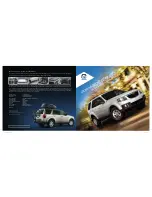
The springs are in a direct line with the side members and therefore taper towards the front. Both sides of the
frame are supported in a straight line over the point of suspension at the axles and no amount of loading can tend
to warp the side members out of line.
The side members are of unusually deep section and all cross members are efficiently braced at the point of
junction with the side member. The cross member, which is immediately over the rear spring bracket is of a box
section, affording absolute rigidity.
All spring brackets are flanged to the side of the channel in addition to being attached to the under section.
The body is not carried over the side member proper but is bolted to separate brackets which are riveted to the
side member flush with the upper flange. This eliminates the necessity of drilling large body bolt holes in the side
member.
Springs
Semi-elliptic springs are employed because they enable us to use a spring of greater length. This would be
impracticable with the three-quarter, or scroll suspension on account of the excessive side sway permitted. It also
enables us to use a practically flat suspension spring, thus affording maximum flexibility for the least weight.
All spring eyes are phosphor bronze bushed and all spring bolts are of exceptionally large diameter, and fitted
with grease cups. Springs are assembled with graphite grease between the leaves to reduce the friction and
improve the riding qualities.
All strain from the axle driving mechanism is taken through the suspension springs. This minimizes shocks
and twisting strains which would otherwise be transmitted through the torque arm to the chassis, at the same time
cushioning such strain by absorbing the shocks in the spring itself. This is known as the Hotchkiss type of drive
and has been in use on our Light Six models for the past three seasons. It is gaining in popularity each year and at
the present time would seem to be the ultimate type of drive.
Rear Axle
The rear axle is of semi-floating construction with pressed steel housing and spiral bevel gears. Except for
modifications and improvements in the adjusting mechanism, it is identical with the axle used on previous
models. A larger section drive shaft and better grade materials insure the higher factor of safety required to
transmit the power of the new type motor.
Brakes
The brakes are of construction common to Hudson cars for the past two seasons and have called for
practically no improvement. They are large in diameter and ample in braking area. Leverage has been worked out
in a manner which insures the maximum amount of braking effect with the minimum effort on the part of the
driver. All adjustments are simple and well exposed so as to render them accessible.
Front Axle
The front axle, while of the same conventional design, has been improved. The tie bar adjustment is of such
construction that it cannot possibly loosen and disarrange the alignment of the front wheels. The tie bar bushings
are of hardened steel and are fitted with grease cups.
The steering knuckles and arms have been strengthened to give added safety at a higher car speed than has been
demanded heretofore.
11
Содержание Super Six 1916
Страница 1: ...Reference Book HUDSON Super Six 1916 MODEL FIRST EDITION ...
Страница 2: ......
Страница 3: ......
Страница 16: ......
Страница 18: ......
Страница 19: ......
Страница 25: ......
Страница 27: ......
Страница 33: ......
Страница 36: ......
Страница 37: ......
Страница 38: ......
Страница 53: ......
Страница 61: ......
Страница 64: ......
Страница 65: ......
Страница 68: ......














































